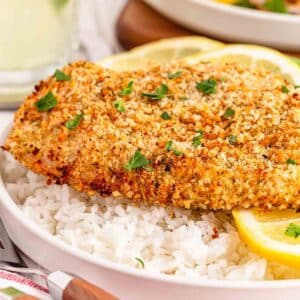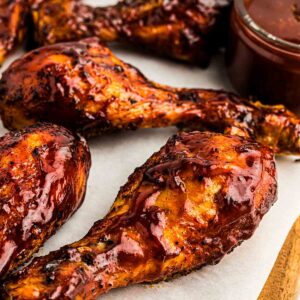When it comes to preparing chicken for cooking, the question ‘should you wash chicken before cooking’ has sparked debates for generations.
While some people advocate for washing chicken before cooking, others strongly advise against it.
In this blog post, we'll delve into the reasons behind these differing opinions including answering the other question why do black people wash chicken and we’ll also explore the best practices for handling chicken in the kitchen.

Table of Contents
Why do Black people wash chicken?
It's important to acknowledge cultural practices and understand why some individuals, including members of the Black community, choose to wash chicken before cooking.
In certain cultures, washing chicken is a tradition that has been passed down through generations. Some people believe that rinsing chicken helps remove surface bacteria and potential contaminants, ensuring a safer meal.
However I’m not sure if it’s only black people who wash chicken before cooking since I’ve read comments on social media platforms where members who have stories of how sometimes meats are not hygienically packaged. Things like picking up meat that has fallen on the floor and packaging without washing it.
There’s also the historical part of it that dates back to the slave trade era where black slaves were made to cook with the leftovers and undesirable parts of meat, like pigs intestines, chicken and Turkey necks, pig feet etc. it’s no wonder they needed to be washed and cleaned thoroughly before cooking.
Well before hearing all these stories, I grew up washing meat before cooking that’s how my mom did it and so did my grandma and so on. I ultimately learned that chicken is always washed thoroughly before cooking so it was a shock to me to find out that washing chicken was a hot topic.

The reason behind the recommendation not to wash chicken
Contrary to popular belief, health experts and food safety organizations recommend against washing chicken before cooking. This advice stems from a better understanding of foodborne illnesses and cross-contamination.
According to the USDA and FDA, when you wash raw chicken, water droplets can spread bacteria to kitchen surfaces, utensils, and other foods, leading to a higher risk of contamination.
Cooking chicken to the recommended internal temperature (165°F or 74°C) effectively kills harmful bacteria, making washing unnecessary.
The Best Way to Handle Chicken
Instead of washing chicken, the focus should be on proper food handling practices to ensure a safe and delicious meal. Here's the best way to handle chicken before cooking:
Unpack Safely: When bringing chicken home from the store, place it in a plastic bag or container to prevent any juices from coming into direct contact with other foods. Store it on the lowest shelf of your refrigerator to prevent cross-contamination.
Clean Hands and Surfaces: Before and after handling chicken, wash your hands thoroughly with soap and water for at least 20 seconds. Additionally, clean all surfaces, utensils, and cutting boards that come into contact with raw chicken using hot, soapy water.
Pat Dry: Instead of rinsing, pat the chicken dry with paper towels. This reduces excess moisture that can lead to splattering during cooking.
Cook Thoroughly: Cooking chicken to the recommended internal temperature is the most effective way to kill harmful bacteria. Use a food thermometer to ensure the thickest part of the chicken reaches 165°F (74°C).

Should you wash chicken before cooking?
Based on the articles shared above, it is recommended that you do not wash chicken before cooking. So it’s up to you to decide how you handle your chicken. I’m not in the position to and can’t make that decision for you.
I’ll share the best way to handle raw chicken as per USDA so you at least know how to do it right. You can also check out the CDC guidelines on this topic
- Unpack Safely: When bringing chicken home from the store, place it in a plastic bag or container to prevent any juices from coming into direct contact with other foods. Store it on the lowest shelf of your refrigerator to prevent cross-contamination.
- Clean Hands and Surfaces: Before and after handling chicken, wash your hands thoroughly with soap and water for at least 20 seconds. Additionally, clean all surfaces, utensils, and cutting boards that come into contact with raw chicken using hot, soapy water.
- Pat Dry: Instead of rinsing, pat the chicken dry with paper towels. This reduces excess moisture that can lead to splattering as you handle it.
- Cook Thoroughly: Cooking chicken to the recommended internal temperature is the most effective way to kill harmful bacteria. Use a food thermometer to ensure the thickest part of the chicken reaches 165°F (74°C).

How I wash chicken
I personally can’t bring myself to cook chicken without washing it. I’ve tried and I honestly can’t so while this section documents my process, I want to be clear that I DO NOT recommend you wash your chicken since it’s definitely not recommended by USDA, FDA and CDC. Kindly stick to the recommended guidelines on their websites.
So why share this article? It is for information purposes only showing how I wash chicken safely in my kitchen which is my personal preference not my recommendation to you.
What I use
- White Vinegar or lemon.
- A deep bowl
- Paper towels
- Chopping board: it’s usually best to dedicate a particular chopping board for meats only to reduce the risk of cross contamination.
Washing chicken
If you choose to wash chicken before cooking, it's essential to do so safely to minimize the risk of cross-contamination and foodborne illnesses. Here's a step-by-step guide on how to wash chicken safely:
Preparation and Setup:
- Clear the surrounding area and ensure that all other food items, utensils, and surfaces are kept away from the chicken.
- Wash your hands thoroughly with soap and water before and after handling the chicken.
Unpack the Chicken:
- Fill a bowl in the sink with cold water. Add some vinegar or lemon juice to the water. Gently lower the chicken into the bowl of water. Don’t throw it in to avoid a splash as this will contaminate the surrounding surface.
- Rinse the chicken while it’s in the bowl, while removing fats or feathers or anything thing that needs to be removed. Pour out the water the add more water to for a second rinse. Be mindful of the water pressure. Let the tap run slowly so that it doesn’t Splash raking contaminating the area.
- Make sure the water pressure is not too strong, as this can spread bacteria.
Pat Dry
- After rinsing, transfer to chopping board before you use paper towels to pat the chicken dry. This helps remove excess moisture so that seasoning and marinades can stick.
Immediate Cleanup
- Dispose of the used paper towels and any packaging in a sealed plastic bag. Wash your hands again after disposing of these items.
- Immediately clean and sanitize the sink, faucet handles, and any surfaces that came into contact with the chicken. Use hot, soapy water to clean and a disinfectant to sanitize.
Follow Through with Safe Cooking Practices:
- Once the chicken is washed and patted dry, continue with safe cooking practices by preparing it immediately and cooking it to the recommended internal temperature of 165°F (74°C).
It's important to note that washing chicken is not a recommended practice by health experts due to the risk of cross-contamination. If you choose to wash chicken, following these steps can help minimize the potential risks. However, using safe food handling practices, such as avoiding cross-contamination, regularly cleaning and sanitizing kitchen surfaces, and cooking chicken to the appropriate temperature, remains crucial in ensuring the safety of your meal.

FAQs
Chicken should be cooked to an internal temperature of 165°F (74°C) to ensure that harmful bacteria are destroyed.
Proper food handling practices, including keeping raw chicken separate from other foods, cooking it to the correct temperature, and maintaining a clean kitchen, are key to ensuring safety.
Health experts advise against washing chicken, as it can lead to cross-contamination and the spread of harmful bacteria. Cooking chicken to the recommended temperature is a safer method.
Some individuals, including those from certain cultural backgrounds, wash chicken to remove potential contaminants and bacteria from the surface.
Washing chicken is not exactly a myth, but it is a practice that health experts and food safety organizations advise against.
The idea behind washing chicken is to remove potential contaminants or bacteria from the surface.
However, this practice can actually increase the risk of cross-contamination and the spread of harmful bacteria.
When you wash chicken under running water, water droplets can splash and spread bacteria to kitchen surfaces, utensils, and other foods.
This can lead to a higher risk of foodborne illnesses. Cooking chicken to the recommended internal temperature of 165°F (74°C) is the most effective way to kill any harmful bacteria and ensure food safety.

In conclusion
In summary, while washing chicken may have cultural or traditional roots, it is not considered a safe or necessary practice. Following proper food handling guidelines, such as
- Keeping raw chicken separate from other foods,
- Cooking it to the appropriate temperature of 165°F (74°C) and
- Maintaining a clean kitchen environment, are more effective ways to ensure the safety of your meals.
Further reading

More Helpful how-to guides
How to cut chicken breast
How to boil chicken thighs
How to cook frozen chicken wings in air fryer
Check out all out how-to guides and chicken dinner ideas!

Did you find this post helpful? Please leave a comment below and let us know your thoughts. Remember to share with family and friends if you found it useful.
Thank you for stopping by. Hope to see you again soon! If you’d love more chicken recipes and tips, sign up for our free newsletter and come hang out with us on Instagram, Facebook, Pinterest, Tiktok and YouTube for updates.
For now…. Let’s cook chicken!
Love it? Pin it!






So what do you think?